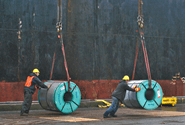Steel Products Prices North America

Steel Imports Decline in February, Defy Prediction in the Months Ahead
Written by Tim Triplett
March 13, 2022
Steel import permit applications for February totaled 2,274,000 net tons—a 24.5% decrease from the 3,013,000 permit tons recorded in January and a 25.3% decrease from the January final imports total of 3,044,000. Import permit tonnage for finished steel in February was 1,759,000, down 22.8% from the final imports total of 2,279,000 in January, reported the American Iron and Steel Institute, based on the latest Commerce Department data.
As of the end of February, steel prices in the U.S. had declined by nearly 50% from record highs last year to levels where foreign mills no longer had a price advantage. Steel Market Update pegged the benchmark price for hot rolled coil on March 1 at $1,000 per ton. Most buyers have been in an inventory-reduction mode for the past few months, postponing purchases as they waited to see how low prices would go. Thus many have reduced orders from mills, both domestic and foreign. Therefore, the decrease in imports in February comes as no surprise.
For the first two months of 2022 (including February SIMA permits and January final imports), steel imports totaled 5,318,000 net tons, a 23.1% increase, including 4,038,000 tons of finished steel, a jump of 51%, compared with the same period in 2021. Imports held a 23% share of the U.S. finished steel market year to date through February, AISI reported.
Steel imports with large increases in February permits versus final January imports include reinforcing bars (up 75%), heavy structural shapes (up 28%) and light shapes bars (up 26%). Products with significant year-to date increases included wire rods (up 118%), oil country goods (up 107%), sheets and strip all other metallic coatings (up 102%) cold rolled sheet (up 100%), and sheets and strip hot-dipped galvanized (up 71%).
Through the first two months of 2022, the largest exporters to the U.S. were Canada (1,030,000 tons, down 5% from the same period last year), Mexico (985,000 tons, up 60%) and Brazil (705,000 tons, down 35%), AISI said.
Steel prices appear to have bottomed in the first week of February and are on the upswing as U.S. mills raise prices in response to big jumps in global raw material costs triggered by the war in Ukraine. Normally, rising prices in the U.S. would attract more steel from overseas, but mills all over the world are dealing with higher costs due to the disruption of slab, pig iron and scrap supplies from Ukraine and Russia. Ripple effects from the conflict in Eastern Europe make prices and the level of steel imports into the U.S. risky to predict in the months ahead.
By Tim Triplett. Tim@SteelMarketUpdate.com

Tim Triplett
Read more from Tim TriplettLatest in Steel Products Prices North America

CRU: Q3 will be the lowest point in current sheet price cycle
CRU Principal Analyst Shankhadeep Mukherjee expects a restocking cycle for steel sheet products in most parts of the world due to either low inventories or seasonally stronger demand.

CRU: US rebar and wire rod prices rise alongside S232 increase
CRU Senior Steel Analyst Alexandra Anderson discusses current market and pricing dynamics for long steel products in the US.

SMU Price Ranges: Sheet and plate steady ahead of Independence Day
Sheet and plate prices were little changed in the shortened week ahead of Independence Day, according to SMU’s latest check of the market.

Nucor maintains plate prices, opens August order book
Nucor aims to keep plate prices flat again with the opening of its August order book.

Nucor CSP remains level at $900/ton
Nucor maintained its weekly list price for hot-rolled (HR) coil this week, following two consecutive increases.
